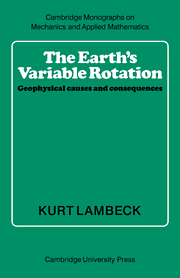Book contents
8 - The Chandler wobble
Published online by Cambridge University Press: 06 October 2009
Summary
The Chandler wobble, discovered in 1891 after a long and fruitless search for a 10-month period in astronomical latitude observations, is still associated with almost as much controversy today as it was then, and many of the questions that were raised by Chandler, Newcomb, Kelvin, Volterra, Larmor, Darwin and others are still with us. These questions relate to the three essential problems associated with the Chandler wobble, (i) Can the lengthening of the period, from the 305 d predicted for a rigid Earth to the observed 434 d, be explained quantitatively? (ii) Being a free motion, the Chandler wobble will ultimately be damped out but the astronomical record of near 150 yr does not show any indication of a gradually diminishing amplitude. What maintains the motion against damping? (iii) If damping occurs, where is the rotational energy dissipated? These are also the questions that we wish to discuss once again in this chapter.
Astronomical evidence for the Chandler wobble has been discussed in chapter 5. The main characteristic is a period of about 434 sidereal days. The broad spectral peak (figure 5.14) is very suggestive of damping and, if a linearly damped oscillation is assumed, the relaxation time is of the order of 25–40 yr; the wobble amplitude would decay to e–l of its original value in something like 25–40 yr. The associated Chandler wobble Q would be of the order of 60–100.
- Type
- Chapter
- Information
- The Earth's Variable RotationGeophysical Causes and Consequences, pp. 195 - 244Publisher: Cambridge University PressPrint publication year: 1980

